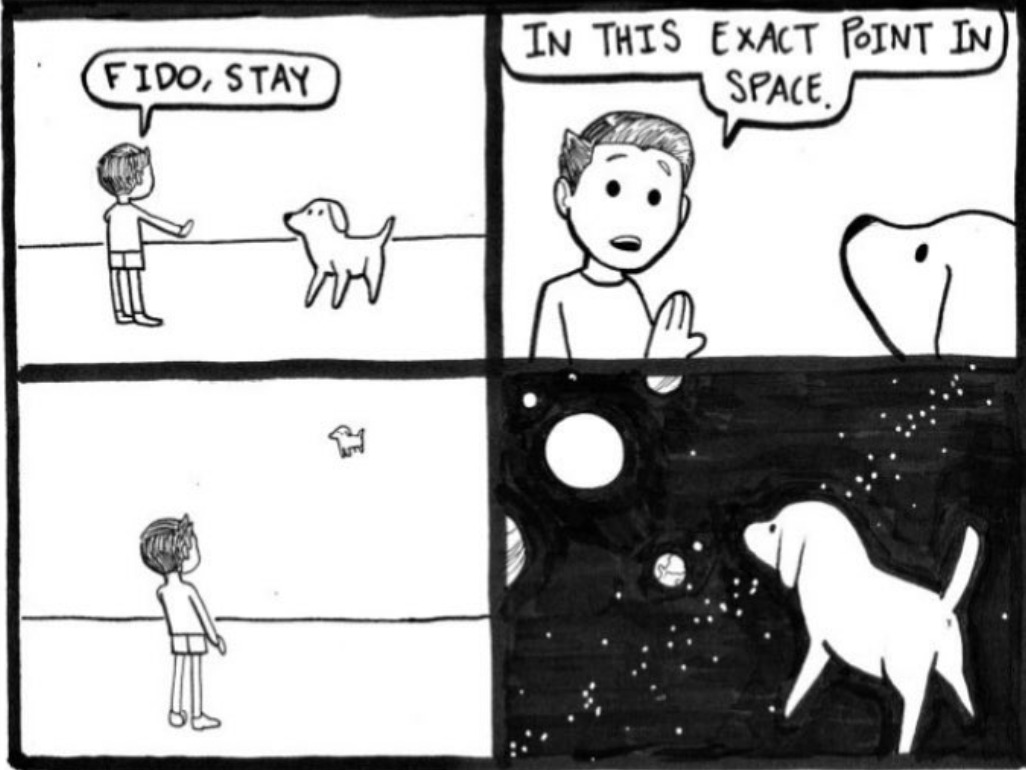So you’re telling me there are space ghosts, from coast to coast? 😮
I’ll be dead long before you were born and I’ll be dead long before you’ll be dead.
It’s ok because they break the rules of thermo dynamics
Thank you for this daily dose of existential dread 👌
This actually explains a lot.
This is incorrect. Ghosts do have mass, they just don’t interact with the EM force and only through the gravity, the strong and the weak interaction (and a fifth interaction that we don’t know about). That’s right, all that dark matter and dark energy is actually ghosts.

Can we define ghosts simply as the extinguished consciences of sentient life? So, dark matter and dark energy are the thoughts and memories of our universe.
With no mass they will continue in a straight line at the velocity they were at when they transcended.
Ghosts everywhere!
This is the best explanation I’ve heard for dark matter that doesn’t involve the assumption that our cosmological models are completely correct.
Relative to what? That makes no sense.
Relative to the Cosmic Microwave Background. Seems to be the closest thing to an absolute reference frame.
The cosmic microwave background has no center, any claims that it even has a direction is controversial.
Is it controversial? I thought it was pretty established. In Wikipedia it says:
From the CMB data, it is seen that the Sun appears to be moving at 369.82±0.11 km/s relative to the reference frame of the CMB (also called the CMB rest frame, or the frame of reference in which there is no motion through the CMB). The Local Group — the galaxy group that includes our own Milky Way galaxy — appears to be moving at 620±15 km/s in the direction of galactic longitude ℓ = 271.9°±2°, b = 30°±3°.[88] The dipole is now used to calibrate mapping studies.
Don’t cite Wikipedia. Look at the tiny numbers in blue, click the one next to the statement you want to verify, it will show you the source of the information at the bottom of the page next to the matching number.
Well, following the main reference in the Wikipedia page leads to this:
The implied velocity for the Solar System barycenter is v = 369.82 ± 0.11 km s−1, assuming a value T0 = Tγ , towards (l, b) = (264.021◦ ± 0.011◦, 48.253◦ ± 0.005◦) [13]. Such a Solar System motion implies a velocity for the Galaxy and the Local Group of galaxies relative to the CMB. The derived value is vLG = 620 ± 15 km s−1 towards (l, b) = (271.9◦ ± 2.0◦, 29.6◦ ± 1.4◦) [13], where most of the error comes from uncertainty in the velocity of the Solar System relative to the Local Group. The dipole is a frame-dependent quantity, and one can thus determine the ‘CMB frame’ (in some sense this is a special frame) as that in which the CMB dipole would be zero. Any velocity of the receiver relative to the Earth and the Earth around the Sun is removed for the purposes of CMB anisotropy studies, while our velocity relative to the Local Group of galaxies and the Local Group’s motion relative to the CMB frame are normally removed for cosmological studies. The dipole is now routinely used as a primary calibrator for mapping experiments, either via the time- varying orbital motion of the Earth, or through the cosmological dipole measured by satellite experiments.
Do any references suggest this dipole is under debate?
Ok, I guess the idea that the CMB suggests movement relative to a quasi-absolute reference frame really has become disputed lately… I also found this newer paper by the same authors. It’s a pity, I liked the idea.

Now we know what dark matter is
The butthole is what really makes this comic
Einstein would like to have a word with you
several physicists are typing…
By this line of thinking, dying in a mass tragedy might be the best thing that could happen to you. At least you wouldn’t be in solitary confinement for eternity.
I mean, I’m sure there’s a statistic that someone can look up but as many people as are on the planet, I feel like there would always be someone within shouting distance if not closer. I guess it really depends on how fast the earth is moving and what the frame of reference is.
You’re underestimating the distances and speeds involved. The earth is traveling at 67,000 mph around the sun and the sun is traveling 514,000 mph around the galactic core and takes 225 million years to do one orbit. Even if two people died within a second of each other, they’d be 100+ miles away from each other.
Here is a sad face…
Earth orbits the sun. The sun orbits the super cluster in the middle of the galaxy. The galaxy is flying off into space being pulled on by other galaxies. The earth will never occupy the same expect space if you factor in all the movements. If you were holding the hand of your loved one and the two of you died withing a thenth of a second apart you would not be able to see them by the time difference at those speeds.
Though its all relative how you want to measure and what you want to measure.
The earth moves at 18 miles per second in orbital velocity alone, there aren’t people within shouting distance of me now, and the opposite site of the planet from me is 80 miles off the coast of Madagascar. If I die at home I’m alone forever unless my wife goes at the same instant.
Yeah, but…imagine if I were in that mass tragedy with you. You’re telling me you wouldn’t rather be alone for eternity, than with me for eternity?
I love you and appreciate you.
Are they also unbound by momentum?
TIL that ghosts are pinned to the lumineferous aether.
With the Earth’s elliptical orbit, momentum would only get you so far in terms of sticking with the planet.
Even with a circular orbit, if you’re unbound by gravity you’ll follow a straight path while the Earth curves, resulting in it appearing to accelerate away from you.
relative to the galactic central point, per Eric Idle, the earth would be 200k/125 miles away in a single second, or relative to everything in the universe / background radiation, it would be 23,000 miles (37,000 km) away in a single second.
Preserving momentum in different directions and you quickly double it
Assuming an even rate of death, that’s just under 2 people dying per second currently, so you wouldn’t even be able to see the people who died before or after you if you retained human senses as a ghost.
If this were true we could then actually use ghosts to determine the “true” universal reference frame, right?
… Boo.
Is the reference frame the CMB? You’d think you could just choose the reference frame at that point and move however you want, but arguing the physics of hypothetical metaphysical beings probably doesn’t make much sense.
That explains why there are no ghosts.
No Earth ghosts, only… Space Ghosts…
We already had a discussion about how that doesn’t make sense with this different comic: https://lemmy.ml/post/14518058

Right, at the very least it would be a non overlapping spiral, as our sun orbits the galactic center
Who’s “we” tho? It’s like a 4 month old post.
Funny tho I wonder if the artist read that thread and got the idea for this comic or if it’s just a case of like minds.
I wonder …

Which is probably what inspired this other comic.
Yeah i has issues with that one this one makes more sense for amount of deaths per day
I think about this way more than I’m happy to admit.
The only things that aren’t bound by gravity are massless. Massless things always have to be moving at the speed of light. So really the question is, what direction would the ghost shoot off to? Momentum would have to be preserved, so it’d be the opposite direction of where the corpse drops. Or maybe the corpse just move a teensy bit to the opposite direction of the ghost?
Note: this assumes Newtonian or at least semi classical physics. In general relativity, there is no such thing as being unbound by gravity.
Morale of the story: Take out as many people as you can when you go so you’re not lonely for eternity.













